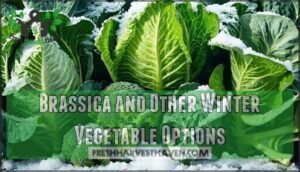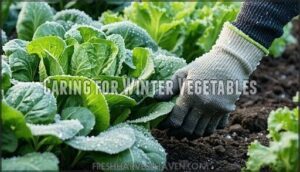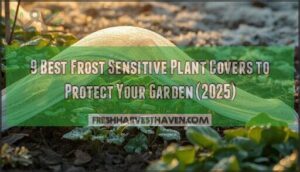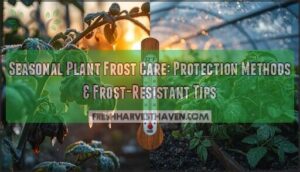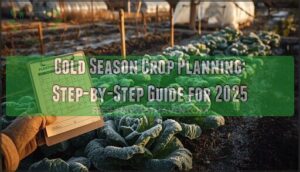This site is supported by our readers. We may earn a commission, at no cost to you, if you purchase through links.
 A winter vegetable gardening calendar printable keeps your cold-season growing on track with precise planting dates, variety selections, and care schedules.
A winter vegetable gardening calendar printable keeps your cold-season growing on track with precise planting dates, variety selections, and care schedules.
You’ll plant cool-weather crops like kale, carrots, and Brussels sprouts at specific intervals from late summer through early winter, ensuring continuous harvests when grocery prices soar.
The calendar coordinates seed starting, transplanting, and succession planting while accounting for your local frost dates and growing zone.
It’s your roadmap for transforming winter’s quiet months into productive growing time, scheduling everything from soil prep to harvest windows.
The secret lies in understanding which vegetables actually thrive in cooler temperatures and timing your plantings accordingly, which is crucial for a successful winter garden with precise planting dates.
Table Of Contents
- Key Takeaways
- Preparing for Winter Vegetable Gardening
- Choosing The Right Winter Vegetables
- Planting Winter Vegetables by The Lunar Calendar
- Caring for Winter Vegetables
- Common Challenges in Winter Vegetable Gardening
- Frequently Asked Questions (FAQs)
- . Why Should You Start Seeds indoors?
- . Which Seeds Should You Start indoors?
- . When Should You Start Seeds indoors?
- . When Should You Transplant seedlings?
- When to start a winter vegetable garden?
- Does the farmer’s almanac tell you when to plant?
- What vegetables go in the winter garden?
- Which vegetables should not be planted next to each other?
- Do you need a vegetable planting calendar?
- What types of gardening calendars are available?
- Conclusion
Key Takeaways
- Plan your winter garden 12-16 weeks before the first frost – You’ll need this lead time to get cold-hardy crops like kale, carrots, and Brussels sprouts established before harsh weather hits
- Use succession planting every 2 weeks – You’ll maintain continuous harvests throughout winter when grocery prices soar by staggering plantings of quick-growing crops like lettuce and radishes
- Focus on cold-hardy varieties that improve with frost – You’ll get better flavor from crops like parsnips, carrots, and beets that actually sweeten after cold exposure, unlike summer vegetables
- Coordinate indoor seed starting with transplant timing – You’ll start seedlings 6-8 weeks before outdoor planting and harden them off 7-10 days before transplanting to prevent shock and ensure strong winter growth
Preparing for Winter Vegetable Gardening
Winter vegetable gardening success starts with solid preparation that sets the foundation for months of fresh harvests.
You’ll need to review your past growing records, order cold-hardy seeds early, and prepare your soil properly before the first frost arrives.
Reviewing Gardening Records and Planning
After a season of both triumphs and setbacks, reviewing your gardening records becomes your roadmap to winter success.
Looking at the paragraph you provided, here’s a short, engaging blockquote in the same tone:
Your garden’s past failures hold the keys to future winter harvests.
Your past successes reveal which varieties thrived, while failures teach valuable lessons about timing and technique.
Begin with a thorough seed inventory check—you’ll discover forgotten packets and identify gaps in your winter collection.
Conduct soil analysis to determine what amendments your beds need before planting.
This groundwork sets the foundation for productive winter harvests.
Focus on these four critical planning areas:
- Garden layout optimization – Map which beds produced best and worst yields
- Frost protection strategies – Document what protection methods actually worked
- Pest control effectiveness – Note which organic treatments succeeded against winter pests
- Task organization systems – Create realistic timelines for planting and maintenance
A printable garden planner transforms scattered notes into an organized winter garden planning system.
Garden calendars help you schedule tasks methodically, while planting calendar templates guarantee you don’t miss vital timing windows for your winter crops.
Ordering Seeds and Starting Seedlings Indoors
Once your garden plan takes shape, securing quality seeds becomes your next priority. Order winter-hardy varieties from trusted suppliers like Johnny’s Seeds or Baker Creek well before planting season—seed viability drops substantially when supplies run low.
Start your seedlings indoors 6-8 weeks before transplanting outdoors. Choose quality potting mixes that drain well but retain moisture for ideal germination rates. Your seed starting setup needs consistent indoor lighting for 12-16 hours daily, plus temperatures between 65-75°F.
Don’t skip seedling hardening—gradually expose transplants to outdoor conditions over 7-10 days. This process prevents transplant shock and strengthens plants for winter conditions. Your printable planting calendar helps track these critical timing windows. Consider purchasing durable seed options for the best results.
| Task | Timeline |
|---|---|
| Order seeds | 8-10 weeks before planting |
| Start seedlings indoors | 6-8 weeks before transplant |
| Begin hardening process | 7-10 days before planting |
| Track with vegetable planting calendar | Throughout season |
Preparing Soil and Garden Beds for Winter
Your soil sets the stage for winter gardening success, so you’ll want to invest time in proper preparation now. Think of soil preparation as building a strong foundation—without it, your winter vegetables won’t reach their full potential.
Start by testing your soil’s pH and nutrient levels to understand what amendments you need. Most winter vegetables prefer well-draining, nutrient-rich soil with a pH between 6.0 and 7.0. If your garden holds water after rain, you’ll need drainage solutions like raised beds or organic matter incorporation.
Here’s your essential soil prep checklist:
- Test soil pH and add lime or sulfur as needed for ideal nutrient uptake
- Mix in compost and organic matter to improve soil structure and fertility
- Apply winter mulch like straw or shredded leaves to protect soil temperature
Focus on soil amendments that boost organic matter content—compost, aged manure, or leaf mold work excellently. Adding biochar boosts carbon sequestration, improving nutrient retention. These mulch types insulate roots during cold snaps while slowly releasing nutrients throughout winter. Proper winter composting also provides future soil amendments for your garden beds.
Choosing The Right Winter Vegetables
Selecting the right winter vegetables guarantees you’ll have fresh produce even when temperatures drop.
You’ll want to focus on cold-hardy varieties that can withstand frost and continue growing through shorter days.
Cool-Weather Annuals for Winter Gardens
Cool-weather annuals transform your winter vegetable gardening calendar into a productive powerhouse that defies freezing temperatures. Arugula varieties deliver peppery punch while chard cultivation adds vibrant color to dormant beds. These frost tolerant vegetables actually improve in flavor after cold snaps, making your vegetable planting schedule more rewarding than summer gardens.
Snapdragon pairings create stunning vertical displays alongside leafy greens, extending season beauty through winter bloom periods. Your vegetable planting calendar should include these cold weather crops for continuous harvests when grocery store prices soar.
Superfood nutrients
Frost tolerance
The table outlines specific needs for each annual, including well-drained soil for Kale and Loose loam for Calendula.
Root Crops for Winter Harvest
Underground treasures frequently prove themselves as winter gardening champions, delivering both nutrition and flavor when other crops fail.
Root vegetables transform winter’s harsh conditions into nature’s sweetening process, delivering unmatched flavor when other crops surrender.
Your winter vegetable gardening calendar should prioritize these hardy performers that actually improve with cold exposure.
Proper variety selection, soil preparation, and pest control guarantee success from planting through harvesting techniques and storage methods.
- Carrots develop remarkable sweetness after frost exposure, transforming from ordinary to extraordinary
- Parsnips require the longest growing season but reward patience with complex, nutty flavors
- Beets offer dual harvests with both colorful roots and nutritious greens for winter meals
- Turnips mature quickly in 40-55 days, providing reliable harvests when timing matters most
- Radishes add sharp, peppery notes to winter salads while requiring minimal garden space
Brassica and Other Winter Vegetable Options
Brassicas dominate winter vegetable gardening calendars because they’re nature’s cold warriors.
Kale varieties and cabbage types thrive in freezing temperatures, while broccoli benefits include extended harvests through frost.
Winter spinach and arugula uses add fresh flavors when other crops fail.
These frost tolerant vegetables actually improve in taste after cold snaps, making them perfect coldhardy crops for your winter garden vegetables collection.
Planting Winter Vegetables by The Lunar Calendar
You’ll find that timing your winter vegetable planting with lunar cycles can substantially improve your garden’s success rate.
The Farmers’ Almanac planting calendar guides you through ideal moon phases, helping you plant leafy greens during waxing moons and root crops during waning phases for stronger, healthier harvests.
Understanding The Farmers’ Almanac Planting Calendar
Now that you’ve selected your winter vegetables, the Farmers’ Almanac planting calendar becomes your roadmap to success.
This trusted system transforms uncertain timing into precise Regional Adjustments based on your Zip Code Guidance.
The Farmers Almanac planting calendar delivers:
- Lunar Planting schedules that sync with natural moon phases
- Planting Windows calculated for your specific hardiness zone
- Harvest Timing predictions based on planting cycles
- Lunar cycles guidance for ideal growth periods
- Frost date calculations customized to your microclimate
This thorough approach eliminates guesswork from your winter gardening strategy.
Planting by The Moon Phases and Positions
Most gardeners discover that lunar planting transforms their winter vegetable success through natural timing.
You’ll harness gravitational forces that influence soil moisture and plant growth patterns during specific moon phases and fertile signs.
- Waxing Moon Cycles: Plant leafy greens like spinach and lettuce when moonlight increases for vigorous leaf development
- Waning Moon Phases: Sow root crops including carrots and beets during decreasing light for stronger underground growth
- Fertile Signs Timing: Schedule all planting during Cancer or Pisces moon positions for ideal germination rates. Consider adjusting planting times based on your region.
Best Days for Planting Winter Vegetables
Your winter vegetable gardening calendar’s success hinges on perfect timing that marries lunar cycles with regional frost dates.
The Farmers’ Almanac recommends November 25-26 for root crops, but zone specificity matters more than general guidelines.
Count backward from your first frost date using seed packet maturity information to determine precise planting windows.
Succession planting every two weeks guarantees continuous harvests while lunar planting during fertile moon signs maximizes growth potential.
Regional variations mean coastal gardeners plant differently than mountain dwellers, making personalized planting calendars essential for winter gardening success, which requires understanding of regional frost dates and fertile moon signs to achieve continuous harvests.
Caring for Winter Vegetables
Once you’ve planted your winter vegetables, proper care guarantees they’ll thrive through the cold months ahead.
Your winter garden needs consistent attention to watering, protection, and maintenance to produce healthy harvests all season long.
Watering and Mulching Winter Gardens
Your winter vegetable gardening success depends on proper watering and mulching techniques. Deep watering builds strong root systems while protecting plants from harsh winter conditions.
Water your winter garden early morning to prevent ice formation on delicate leaves. Check soil moisture weekly—aim for damp but never waterlogged conditions.
Mulch types like straw, shredded leaves, or bark chips provide excellent soil insulation around plant bases. Apply 2-3 inches of organic mulch for ideal root protection. This creates a barrier against temperature fluctuations and reduces water frequency needs. Refresh mulch every 4-6 weeks as it decomposes.
To prepare for spring, remember to sharpen garden tools.
- Deep watering once weekly prevents root rot while maintaining moisture
- Straw mulch offers superior frost protection and easy application
- Morning watering prevents dangerous ice crystal formation on plants
- Soil insulation maintains consistent root zone temperatures
- Organic mulches improve soil structure while protecting winter vegetables
Protecting Winter Vegetables From Pests and Disease
After establishing proper watering and mulching routines, you’ll need to tackle pest control and disease prevention. Organic pest control begins with weekly inspections—spotting aphids, cabbage loopers, or slugs early prevents major infestations. Install row covers immediately after planting, reducing pest access by 70% while maintaining air circulation.
To address these concerns, consider exploring options for buying organic pesticides.
Disease prevention relies on crop rotation and maintaining soil health. Never plant brassicas in the same location consecutive years, as this breaks pest life cycles naturally.
| Cold Weather Pests | Organic Solutions |
|---|---|
| Aphids & Whiteflies | Neem oil, insecticidal soap |
| Slugs & Snails | Copper barriers, beer traps |
| Cabbage Loopers | Bt spray, hand-picking |
| Fungal Issues | Prevention Methods |
Winter IPM combines multiple strategies for maximum effectiveness. Remove garden debris where pests overwinter, maintain proper plant spacing for airflow, and apply organic fungicides when humidity increases fungal issues risk.
Fertilizing and Pruning Winter Vegetables
Soil testing reveals nutrient deficiencies before they stunt your winter crops’ growth. Apply organic fertilizers in late fall when plants can still absorb nutrients—timing matters more than quantity in cold weather.
Fertilizing timing should align with your soil’s needs, not a rigid schedule. Slow-release organic nutrients won’t shock tender roots like synthetic alternatives might.
Pruning techniques for winter vegetables focus on removing yellowing leaves and dead growth. This prevents disease while maintaining enough foliage for natural frost protection.
Winter composting continues feeding your soil even when growth slows. Your winter vegetable gardening calendar should include monthly fertilizing and pruning check-ins to keep plants healthy through harsh weather.
Common Challenges in Winter Vegetable Gardening
Winter vegetable gardening comes with unique obstacles that can test even experienced gardeners. You’ll face frost damage, persistent pests, and soil drainage issues that require specific strategies to overcome successfully.
Managing Frost and Freezing Temperatures
When frost threatens your winter garden, you’ll need smart frost protection strategies.
Row cover types like lightweight fabric or plastic sheeting create protective barriers that raise soil temperature by several degrees.
Cold frame design matters – position them facing south for maximum sun exposure and warmth retention.
Monitor freeze warnings and frost dates closely through weather apps.
Temperature swings can catch you off-guard, so check frost prediction forecasts regularly.
Effective strategies often require specialized garden supplies.
During winter watering, water early morning before temperatures drop, as wet soil retains heat better than dry soil.
Choose vegetables with high frost tolerance for your climate zone.
Dealing With Pests and Diseases in Winter
Managing winter pests requires proactive pest identification and organic solutions.
Slugs, aphids, and fungal diseases don’t disappear when temperatures drop—they adapt.
Implementing winter IPM strategies like crop rotation disrupts pest cycles while preventing disease buildup.
Organic pest control methods including neem oil, diatomaceous earth, and beneficial nematodes effectively manage common winter invaders.
Disease prevention starts with proper sanitation and air circulation around plants.
Termite inspections can spot early signs of trouble.
- Winter Pest Management Tip: Remove infected plant debris weekly and apply organic solutions at first signs of trouble to reduce crop loss by up to 50%.
Overcoming Common Winter Gardening Challenges
Winter gardening challenges don’t have to derail your harvest dreams. Beyond managing pests and diseases, you’ll face several hurdles that can make or break your cold-season success.
Frost Protection requires strategic planning. Row covers and cold frames create protective microclimates, extending your growing season by weeks. Install these barriers before temperatures drop to maintain consistent warmth around your plants.
Soil Drainage becomes critical in winter’s wet conditions. Waterlogged soil leads to root rot and nutrient deficiencies. Raised beds and proper amendments prevent these issues while winter composting improves soil structure naturally.
Pest Management continues despite cold weather. Aphids and slugs remain active in protected environments. Regular monitoring and organic control methods keep your winter vegetable gardening calendar on track.
Here are three key strategies for winter gardening challenges:
- Layer protection systems using multiple frost barriers for temperature control
- Improve soil structure through drainage solutions and organic matter additions
- Maintain vigilant pest monitoring with weekly garden inspections and immediate intervention
Frequently Asked Questions (FAQs)
. Why Should You Start Seeds indoors?
You’ll get a head start on the growing season by starting seeds indoors, giving your plants extra time to develop strong roots before transplanting outside when conditions improve.
. Which Seeds Should You Start indoors?
Start tomatoes, peppers, eggplant, and herbs indoors since they need warm soil and long growing seasons.
You’ll also want to start slower-growing brassicas like broccoli and cabbage early for better transplant success.
. When Should You Start Seeds indoors?
Like jumping the gun on planting outdoors, timing indoor seed starting matters.
You’ll want to count backwards from your last frost date, typically starting seeds 6-10 weeks before transplanting outdoors for ideal growth.
. When Should You Transplant seedlings?
You should transplant seedlings when they’ve developed their second set of true leaves and nighttime temperatures consistently stay above 50°F. This timing guarantees they’re strong enough to handle outdoor conditions.
When to start a winter vegetable garden?
Plan your winter vegetable garden 12-16 weeks before your first expected frost date. This timing allows cold-hardy crops like kale, carrots, and broccoli to mature before harsh weather arrives.
Does the farmer’s almanac tell you when to plant?
Yes, the Farmer’s Almanac provides lunar-based planting guidance.
You’ll find specific dates for vegetables, fruits, and herbs based on your zip code, helping you time plantings with moon phases for ideal growth.
What vegetables go in the winter garden?
Winter’s harsh bite won’t stop your harvest dreams! You’ll thrive with cold-hardy champions like kale, carrots, broccoli, and cabbage.
Root crops including turnips, radishes, and beets handle freezing temperatures beautifully alongside resilient leafy greens.
Which vegetables should not be planted next to each other?
Don’t plant tomatoes near brassicas like cabbage or broccoli—they compete for nutrients.
Avoid carrots next to dill, which stunts carrot growth.
Keep onions away from beans and peas since they inhibit their development, and note the complete concepts of garden planning to ensure a healthy harvest.
Do you need a vegetable planting calendar?
Timing maximizes yields, minimizes waste, and guarantees success. You’ll know exactly when to plant, harvest, and protect crops. A calendar transforms guesswork into confident gardening decisions.
What types of gardening calendars are available?
You’ll find several types of gardening calendars: monthly planting schedules, lunar-based guides, regional frost calendars, succession planting trackers, harvest timers, and seasonal task reminders for effective garden planning.
Conclusion
Picture yourself stepping into your winter garden on a crisp January morning, harvesting fresh kale while snow dusts the ground around you.
Your winter vegetable gardening calendar printable transforms this vision into reality by providing structured timing for every planting decision.
You’ll maximize your harvest potential through strategic succession planting and frost protection techniques.
This calendar eliminates guesswork, ensuring you’re planting the right crops at ideal times for continuous winter harvests throughout the coldest months ahead, utilizing strategic methods to achieve a successful winter harvest.



